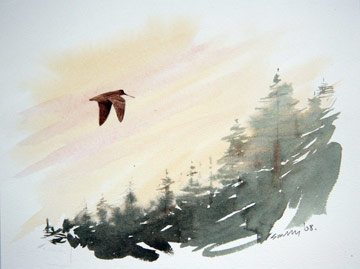
Woodcock © Ray Scally
Most British Woodcocks are sedentary, but their numbers are dwarfed in winter by those of birds from the northeast, with migrants outnumbering residents by about 13:1 in midwinter (Migration Atlas). Birds generally arrive on the November full moon, mainly from Fennoscandia and the Baltic states, with a few from Russia; one ringed in Lithuania was shot at Thurstaston (SJ28M) on 24 November 2003. When they first come in overnight, Woodcocks are prone to turning up in odd places including, in foggy weather, flying into tall buildings. Amongst those recorded in this survey were birds brought into a veterinary surgery in Birkenhead and caught by a cat in Tarporley, both released unharmed. The Atlas map shows them widely distributed across Cheshire, at all altitudes, although avoiding urban areas and sparse on Wirral.
In winter, Woodcocks mostly feed in fields at night, mainly eating earthworms and preferring areas with permanent, frost-free pasture or long-rotation grass leys because these offer the highest density of invertebrate foods. During the day they rest within woodland or scrub within about 1 km of the feeding sites, and their winter distribution is determined mainly by the availability of suitable nocturnal feeding areas rather than diurnal cover; these relaxed habitat requirements mean that they are found in a much wider range of woodland than in the breeding season, with even some quite small patches of scrub often holding Woodcock during the day.
Because they leave the woods after sunset and return before sunrise, most birds are recorded in their daytime loafing areas rather than where they feed, and the submitted habitat codes reflect this bias. 59% of the records were in woodland, including 12% in waterlogged carr, with 10% in scrub, mostly regenerating natural or semi-natural woodland. There were odd records from wet pastures and rushy fields, with 5% in bogs, 7% on farmland, mostly grassland or stubble, and 6% in freshwater sites, mostly narrow watercourses. Woodcocks are susceptible to cold winters when the ground freezes, and then tend to seek unfrozen areas in ditches or alongside small streams.
Most birds were found singly, accounting for two-thirds of the Atlas records, and they spread out in separate areas when feeding although several can share a favoured daytime site: there were three records of four birds, three of five and two of six, all eclipsed by the figures of up to twenty counted in Moss Wood on the Cholmondeley estate (SJ55K). Some large totals are occasionally reported from shooting estates. Figures from the Game and Wildlife Conservation Trust show an average of about 1.5 birds shot annually per km2 of estate area, with little change in this number from the beginning of the 20th century.
Coward (1910) knew the species as a winter resident in varying numbers, occurring in all parts of Cheshire, and Bell (1962) suspected that it was under-recorded and wrote that ‘as a winter visitor it must be much commoner than the records indicate’. That comment probably still applies nowadays, and an element of luck is needed to find Woodcocks, but this Atlas map shows them to be widespread and is probably the most comprehensive ever assessment of their winter distribution in the county.
Sponsored by John E. Ashworth

